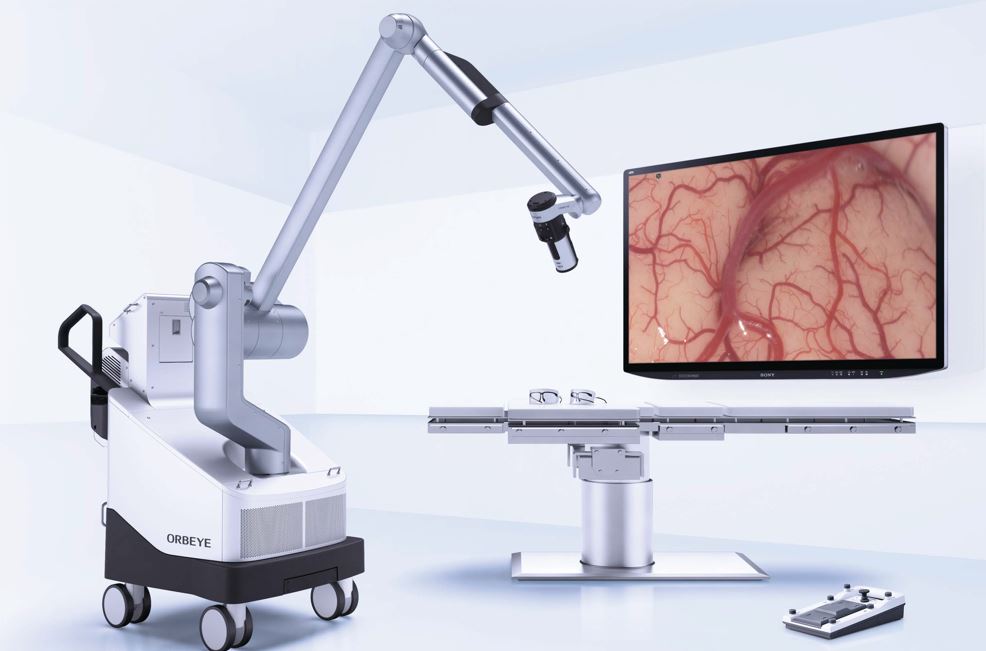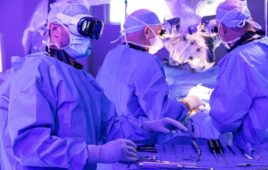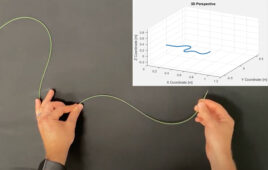Olympus has announced the launch of its 4K-3D Video Microscope, ORBEYE. The new microscope was developed by Sony Olympus Medical Solutions Inc, (SOMED) a joint venture between Olympus Corporation and Sony Imaging Products & Solutions Inc.
The precise 4K-3D digital images from the new ORBEYE microscope can enable more accurate surgery by providing high-resolution 3D imaging of the structure of tissue, blood vessels, and other features. By displaying the progress of surgical procedures on a large 55-inch monitor, the new model has the potential to both reduce surgeon fatigue by eliminating the need for extensive viewing via microscope eyepieces and to include the entire surgical team in the view of the procedure. Because the use of digital technology has made the new microscope unit approximately 95 percent smaller in volume above the surgical field than the previous model, it additionally helps free up surgical space and shortens setup times. The microscope unit was also made 50 percent lighter than the previous model to facilitate its transportation between operating rooms. The device will be marketed by Olympus Corporation.

(Image credit: Olympus)
The benefits of ergonomics, improved precision and ease of positioning in the OR are the result of the following features:
- High-resolution 4K-3D digital images supporting precision surgery — the two Sony 4K ExmorRTM CMOS image sensors deliver high-sensitivity, low-noise images. The system deploys an image processing circuit designed to work across a wide color range as well as with four times the pixel count of the Full High Definition standard to provide high-resolution digital images during surgery. Because it additionally minimizes the delay associated with the large amounts of data that need to be processed by 4K-3D systems, ORBEYE provides zero image latency for smoother viewing and manipulation of the target location.
- Use of 55-inch 4K 3D monitor helps reduce surgeon fatigue and facilitates team surgery — The new model displays via a monitor and has no eyepiece. This helps reduce surgeon fatigue by allowing a more comfortable working posture without requiring them to spend long periods peering into a microscope lens. Moreover, because the large 55-inch monitor enables the entire surgical team to view the same image, it allows more than one surgeon to operate and improves efficiency by allowing information to be shared with other surgical staff.
- Significant reduction in microscope size (95 percent smaller than previous model) helps free up surgical space and shortens setup times — the use of digital technology has made the microscope unit much smaller and it therefore provides the surgeon with additional space to perform operations. The unit’s reduced size also allows faster setup times by eliminating the need to make often awkward adjustments to the balance of the arm, and by allowing use of a smaller and easier-to-fit surgical drape to keep the microscope clean.
“The ORBEYE exoscope represents the next generation of operative imaging- a true quantum shift,” says David Langer, MD, Lenox Hill Hospital/Northwell Health. “Its adoption is certain and will impact the use of loupe magnification as well as the current operating microscope. The ease of use, surgeon ergonomics and effects upon the operating team are revolutionary and I look forward to continuing to train and develop new strategies for its adoption.”
“We have already received resounding enthusiasm for our 4K and 3D technology for laparoscopy and endoscopy. We are pleased that through the development of ORBEYE, this 4K-3D technology can be offered to more specialties such as neurosurgery, spine, microsurgery, ENT, and cardiac,” says Randy Clark, Group Vice President of the Surgical Division at Olympus America Inc. “We understood that with such complex and lengthy surgeries, the technology would have to be innovative and groundbreaking enough to entice surgeons to make a change, and we were pleased to work with SONY through our SOMED joint venture to meet the challenge.”




